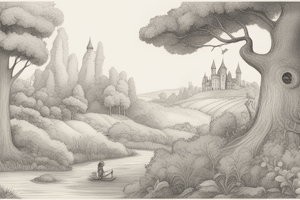Podcast
Questions and Answers
What is the primary function of the respiratory system?
What is the primary function of the respiratory system?
- Facilitate digestion
- Enable gas exchange (correct)
- Support the immune system
- Regulate body temperature
Which part of the respiratory system is responsible for producing sound?
Which part of the respiratory system is responsible for producing sound?
- Bronchi
- Larynx (correct)
- Trachea
- Pharynx
During inspiration, what happens to the diaphragm?
During inspiration, what happens to the diaphragm?
- It remains unchanged
- It contracts and flattens (correct)
- It relaxes and flattens
- It contracts and domes upward
What drives the process of gas exchange in the lungs?
What drives the process of gas exchange in the lungs?
Which structure carries air directly to the lungs?
Which structure carries air directly to the lungs?
What primarily controls the rate of breathing?
What primarily controls the rate of breathing?
What is a characteristic of asthma?
What is a characteristic of asthma?
Which muscles are primarily involved in the process of expiration?
Which muscles are primarily involved in the process of expiration?
Flashcards
What is gas exchange?
What is gas exchange?
The process of taking in oxygen and releasing carbon dioxide. It involves the nose, pharynx, larynx, trachea, bronchi, and lungs.
What are the lungs and what do they do?
What are the lungs and what do they do?
The primary organs of gas exchange in the respiratory system. Tiny air sacs called alveoli within the lungs allow for the diffusion of oxygen into the bloodstream and carbon dioxide out.
What is inspiration?
What is inspiration?
The process of inhaling air into the lungs. The diaphragm and external intercostal muscles contract, increasing the volume of the chest cavity.
What is expiration?
What is expiration?
Signup and view all the flashcards
How does gas exchange occur?
How does gas exchange occur?
Signup and view all the flashcards
What is the medulla oblongata?
What is the medulla oblongata?
Signup and view all the flashcards
What are chemoreceptors?
What are chemoreceptors?
Signup and view all the flashcards
What is asthma?
What is asthma?
Signup and view all the flashcards
Study Notes
Structure and Function
- The respiratory system is responsible for gas exchange, taking in oxygen and releasing carbon dioxide.
- It comprises the nose, pharynx, larynx, trachea, bronchi, and lungs.
- The nose filters, warms, and humidifies inhaled air.
- The pharynx (throat) serves as a passageway for both air and food.
- The larynx (voice box) contains vocal cords for sound production.
- The trachea (windpipe) is a rigid tube that carries air to the lungs.
- The bronchi are two branches of the trachea leading to the lungs.
- The lungs are the primary organs of gas exchange. They contain numerous alveoli, tiny air sacs where oxygen diffuses into the bloodstream and carbon dioxide diffuses out.
Mechanics of Breathing
- Breathing involves two main processes: inspiration (inhaling) and expiration (exhaling).
- Inspiration is an active process driven by the diaphragm and external intercostal muscles.
- Contraction of the diaphragm flattens it, increasing the volume of the thoracic cavity. Contraction of the external intercostals elevates the ribs, further expanding the chest cavity.
- This expansion reduces pressure inside the lungs, drawing air in.
- Expiration is a passive process, primarily relying on the elastic recoil of the lungs and chest wall.
- Relaxation of the diaphragm and external intercostal muscles allows the rib cage to descend and the diaphragm to dome upward. This reduces lung volume and increases pressure, forcing air out.
Gas Exchange
- Gas exchange occurs across the thin walls of the alveoli and capillaries.
- Oxygen from the inhaled air diffuses across the alveoli into the capillaries.
- Carbon dioxide from the bloodstream diffuses across the capillaries into the alveoli to be exhaled.
- This process is driven by differences in partial pressures of gases.
Control of Breathing
- Breathing is largely controlled by the medulla oblongata in the brainstem.
- Chemoreceptors in the medulla and other locations monitor blood levels of oxygen, carbon dioxide, and pH.
- Adjustments in breathing rate and depth are made to maintain homeostasis.
- Higher brain centers (e.g., cerebral cortex) can influence breathing, allowing for voluntary control to some degree.
Diseases and Disorders
- Common respiratory diseases include asthma, chronic obstructive pulmonary disease (COPD), cystic fibrosis, and pneumonia.
- Asthma involves inflammation and narrowing of the airways.
- COPD includes conditions like chronic bronchitis and emphysema, characterized by persistent obstruction of airflow.
- Cystic fibrosis is a genetic disorder affecting mucus production in the lungs, potentially leading to infections.
- Pneumonia is an inflammation of the lungs often caused by infection.
Environmental Factors
- Air pollution can negatively impact lung function and increase the risk of respiratory diseases.
- Exposure to allergens and irritants can trigger allergic reactions and inflammation in the respiratory tract.
Studying That Suits You
Use AI to generate personalized quizzes and flashcards to suit your learning preferences.




